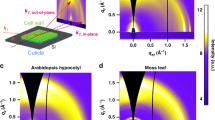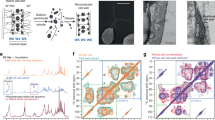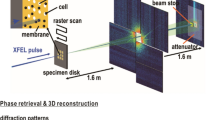Abstract
THERE are few high resolution electron microscope studies specifically concerned with the architecture of the cell walls of the green alga Chlamydomonas. Sager and Palade1 state that the wall of C. reinhardi is a multilayered structure about 40.0 nm thick and that the structure is consistent with the cellulose wall described from light microscope observations. The description of the wall given by Walne2,3 and by Cavalier-Smith4 is essentially similar to that given by Sager and Palade. Barnett and Preston5 using the freeze etching technique reported the presence of oriented microfibrils in the cell walls. The regular features were interpreted as being cellulose which was thought to be synthesized by small granules associated with the surface of the plasmalemma. In the related species C. moewusii the wall had a regular periodicity of 23.3 nm, and again the striations were interpreted6 as being cellulose fibrils, but it was noted that the spacings were smaller than those observed in other structures containing cellulose fibrils7.
This is a preview of subscription content, access via your institution
Access options
Subscribe to this journal
Receive 51 print issues and online access
$199.00 per year
only $3.90 per issue
Buy this article
- Purchase on Springer Link
- Instant access to full article PDF
Prices may be subject to local taxes which are calculated during checkout
Similar content being viewed by others
References
Sager, R., and Palade, G. E., J. Biophys. Biochem. Cytol., 3, 463 (1957).
Walne, P. L., Amer. J. Bot., 53, 908 (1966).
Walne, P. L., Amer. J. Bot., 54, 564 (1967).
Cavalier-Smith, T., thesis, Univ. London (1967).
Barnett, J. R., and Preston, R. D., Proc. Roy. Microsc. Soc., 4, 135 (1969).
Lewin, R. A., Owen, M. J., and Melnick, J. L., Exp. Cell Res., 2, 708 (1951).
Mühlethaler, K., Biochim. Biophys. Acta, 3, 527 (1949).
Horne, R. W., and Davies, D. R., Septième Congrès Intern. de Microscopie Électronique, Grenoble, 3, 117 (1970).
Klug, A., and De Rosier, D. J., Nature, 212, 29 (1966).
Davies, D. R., and Plaskitt, A., Genet. Res., 17, 33 (1971).
Salton, M. R. J., The Bacterial Cell Wall, 42 (Elsevier, Amsterdam, 1964).
Gotelli, J. B., and Cleland, R., Amer. J. Bot., 55, 907 (1968).
Kosta, V., and Carpenter, F. H., J. Biol. Chem., 239, 1799 (1964).
Glauert, A. M., and Thornley, M. J., Ann. Rev. Microbiol., 23, 159 (1969).
Author information
Authors and Affiliations
Rights and permissions
About this article
Cite this article
HORNE, R., DAVIES, D., NORTON, K. et al. Electron Microscope and Optical Diffraction Studies on Isolated Cell Walls from Chlamydomonas. Nature 232, 493–495 (1971). https://doi.org/10.1038/232493a0
Received:
Published:
Issue Date:
DOI: https://doi.org/10.1038/232493a0
This article is cited by
-
Transgenic and cell wall-deficient Chlamydomonas reinhardtii food affects life history of Daphnia magna
Journal of Applied Phycology (2020)
-
Cellulose degradation and assimilation by the unicellular phototrophic eukaryote Chlamydomonas reinhardtii
Nature Communications (2012)
-
Extraction by lithium chloride of hydroxyproline-rich glycoproteins from intact cells of Chlamydomonas reinhardii
Planta (1985)
-
Isolation of protoplasts by means of a ?species-specific? autolysine inChlamydomonas
Protoplasma (1976)
-
Cell wall organisation in Chlamydomonas reinhardi
Molecular and General Genetics MGG (1972)
Comments
By submitting a comment you agree to abide by our Terms and Community Guidelines. If you find something abusive or that does not comply with our terms or guidelines please flag it as inappropriate.



